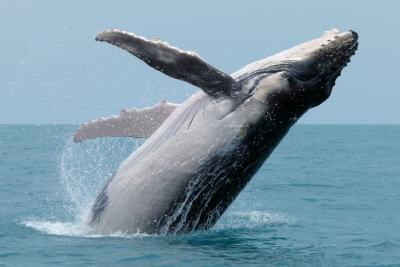
Humpback whales are found in every ocean in the world. Their Latin name, Megaptera novaeangliae, means “big wing of New England.” It refers to their giant pectoral fins, which can grow up to 16 feet long, and their appearance off the coast of New England, where European whalers first encountered them. They have dark backs, light bellies, pleats on their throats, and a small hump in front of their dorsal fins, leading to the common name of “humpback.”
Humpback whales are known for their magical songs, which travel for great distances through the world’s oceans. These sequences of moans, howls, cries, and other noises are quite complex and often continue for hours on end. Scientists are studying these sounds to decipher their meaning. It is most likely that humpbacks sing to communicate with others and to attract potential mates. Humpback calves are known to “whisper” to their mothers.
These baleen whales are found near coastlines, feeding on tiny shrimp-like krill, plankton, and small fish. Humpbacks migrate annually from summer feeding grounds near the poles to warmer winter breeding waters closer to the Equator. Mothers and their young swim close together, often touching one another with their flippers with what appear to be gestures of affection. Females nurse their calves for almost a year, though it takes far longer than that for a humpback whale to reach full adulthood. Calves do not stop growing until they are 10 years old.
Humpbacks are powerful swimmers, and they use their massive tail fins, called flukes, to propel themselves through the water and sometimes completely out of it. These whales, like others, regularly leap from the water, landing with a tremendous splash. Scientists aren’t sure if this breaching behavior serves some purpose, such as cleaning pests from the whale’s skin, or whether whales simply do it for fun.
Credit : National Geographic
Picture Credit : Google




